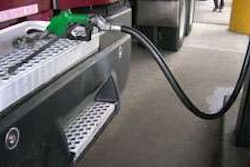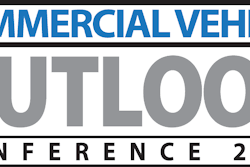Peterbilt Motors Co. on Tuesday, Aug. 23, hosted America’s Natural Gas Alliance for an educational presentation showcasing Peterbilt’s family of alternative fuel vehicles, highlighting their lower operating costs, lower emissions benefits and the performance capabilities. The truck maker also announced additional options for the Model 382, offering higher axle ratings, horsepower and torque configurations to an expanded market range.
The ANGA meeting included test drives in Peterbilt’s alternative gas vehicles and a tour of the company’s manufacturing plant in Denton, Texas. “Peterbilt is committed to providing customers environmentally sound solutions that meet their business objectives,” says Bill Jackson, Peterbilt general manager and Paccar vice president. “By collaborating with ANGA, we can combine our ideas and resources to continue developing alternative fuel technologies and the supporting infrastructure, and promote the environmental benefits and the use of domestically sourced fuel.”
Representing more than 30 of North America’s largest independent natural gas exploration and production companies, ANGA promotes the economic, environmental and national security benefits of clean, domestic NG through joint activities focused on infrastructure development, vehicle production, marketing and education for clean transportation solutions.
The ANGA members involved in the meeting test drove Peterbilt’s Model 386 equipped with the Westport GX engine and the Model 384 equipped with the Cummins Westport ISL-G engine. In addition, test drives were available in two diesel engine trucks, the Model 587 and Model 384, to demonstrate Peterbilt’s NG vehicles offer equal horsepower, torque and service capabilities of a diesel engine truck.
“Vehicles like those Peterbilt is manufacturing are integral to helping our country use clean, abundant, domestic natural gas,” says Tom Hassenboehler, ANGA’s vice president of policy development and legislative affairs. “Greater use of natural gas vehicles will help clean the air in communities across the country and can increase use of domestic energy sources, all while helping drive our economy forward.”
Peterbilt’s family of alternative fuel trucks includes Model 367 LNG, powered by liquefied NG and suited for vocational applications; and Model 386 LNG, suited for line, bulk and tanker hauling. Both are equipped with the Westport HD GX engine and offer up to 475 hp and 1,750 lb-ft of torque. The 15-litre engine uses high-pressure direct injection technology, cryogenic fuel tanks and associated electronic components to facilitate robust performance and reliable operation while reducing greenhouse gas emissions by 25 percent.
Models 320, 365 and 384 are equipped with the Cummins Westport ISL G engine and can be coupled with either compressed natural gas (CNG) or LNG fuel systems. With ratings up to 320 hp and 1,000 lb-ft of torque, ISL G-powered trucks are suited for short-haul, regional, refuse and dump applications.
Already suited for regional and short-haul applications, the Model 382, available in both truck and tractor configurations, now is suited to meet municipal specifications and a variety of construction, refuse, fire service and emergency applications. “Peterbilt is focused on providing its customers with competitive advantages that enable them to operate more efficiently and effectively,” Jackson says. “We have enhanced the already versatile Model 382 with greater component flexibility to make it the ideal vehicle for an expanded range of applications and customers seeking to achieve an ideal balance of power and weight.”
New options on the Model 382 include:
• The Cummins ISL9 engine with REPTO functionality;
• Front axles rated up to 20,000 pounds;
• Rear axles rated up to 46,000 pounds;
• Frame rail options up to 11-5/8 inches;
• The Bendix ESP Stability system for truck applications; and
• Hendrickson, Reyco and Chalmers rear suspension choices.
“The marketplace has already embraced the Model 382’s maneuverability, fuel efficiency and operator comfort and safety amenities,” says Jackson. “These new options will bring these established features to markets requiring robustness, durability and versatility for off-road and specialty operations.”
The Model 382 is powered by a Cummins ISL9 engine, while an improved electronic control module air flow are designed to allow the ISL9 to run stronger and with greater responsiveness. Ratings range from 345 to 380 hp with a maximum 1,300 lb-ft of torque. The Model 382 also features a 50-degree wheel cut designed to allow drivers to maneuver in congested urban environments as well as in tight loading and unloading conditions.
The cab was designed to offer driver comfort and safety. A sloped hood helps provide optimal visibility, while a technologically advanced forward-lighting system is designed to produce both a broader and brighter lighted area. With backlit gauges, contoured door panels and rocker switches placed within easy reach, the driver’s operating environment is designed ergonomically to enhance driver alertness, comfort and productivity. The HVAC system has been redesigned for added airflow while reducing maintenance costs.













